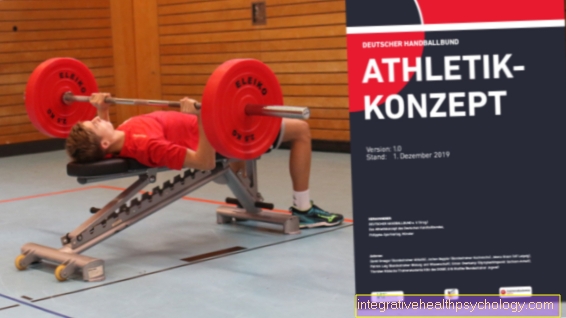Speed strength training
What is speed strength training?
Speed strength training is a form of strength training in which the same muscle fibers are used, but the central nervous system controls the muscle fibers in a different way.
In contrast to endurance training, strength training and thus also high-speed strength training stress the so-called white muscle fibers, which are able to build up a lot of strength for a short time, but tire really quickly.
The speed strength training ensures a better interaction of the individual muscle fibers within a muscle as well as the different muscles of a muscle group.

How do you do speed strength training?
In principle, speed strength training can be performed for any muscle group for which normal strength training can also be performed.
It is advisable to choose the weight to be moved so that it is between a quarter and half the weight that could be moved a maximum of once in this exercise. If this so-called “one-rep maximum” for bench presses is 100 kg, for example, the weight for high-speed strength training should be between 25 and 50 kg.
After an extensive warm-up, not only in general, but also specifically for the muscles that are used during the exercise, the actual speed strength training can begin. The athlete tries to move the weight from the resting position as quickly as possible and to increase speed while performing the movement. When the full range of motion is reached, the weight is slowly brought back to the resting position, from which the new repetition is started. An exercise in speed strength training should be done with three to five sets, with the set consisting of five to eight repetitions.
This article might also interest you: The best strength training exercises
What should be considered?
With high-speed strength training it is - as with hardly any other form of training - extremely important to warm up the muscles to be used before the actual training in order to keep the risk of injury as low as possible.
In addition, it is advantageous to do a speed strength training only when you have already seen a significant increase in strength in your body. Simple strength training is the more effective training method, especially for beginners. As already mentioned in the above section, strength training and speed strength training use the same muscle fibers, so that each strength training also always trains speed strength and vice versa.
You might also be interested in this topic: Weight training without equipment
How often should you do speed strength training?
The “need” for speed strength training is always based on the personal needs of the athlete. Athletes or martial artists, however, benefit from more frequent speed strength training than the common hobby athlete, who focuses on improving their fitness.
For amateur athletes, various sources recommend adding a block of speed strength training to the training plan approx. Every ten weeks or approx. Four times within a year. For athletes, roughly double the frequency, i.e. up to eight times within a year, is recommended. However, not immediately after a competition in order to keep the muscles as rested and efficient as possible for this exertion.
These risks of injury exist
Speed strength training is probably the type of training that offers the greatest risk of injury. Common mistakes that can cause an injury are, on the one hand, the use of excessive weight and, on the other hand, insufficient warming of the muscles to be trained. Due to the strong acceleration, the force acting on the muscles is greater, despite the lower weight, than with normal strength training with higher weights.
Poor posture can lead to joint damage during high-speed strength training, just like strength training, which can lead to premature osteoarthritis. However, the strong stress on the muscles can also lead to injuries to the muscles. Starting with strains to torn muscle fibers or, in the worst case, a muscle tear, any injury is possible. However, this risk can be minimized by extensive warm-up and observing the specified weight, so that no one has to be afraid of speed strength training.
You may also be interested in this topic: Maximum strength training
Special speed strength training for football
Speed strength training in football is usually interesting for the so-called kick-off, i.e. the beginning of the sprint to the ball or the acceleration after capturing the ball, for example.
Short sprints are particularly suitable for this, in which maximum acceleration is to be achieved within the first five to ten meters. The sprint can be started from a standing position, but also, for example, from a lying position or after a small coordinative task.
If, for example, sprint sleds or sprint belts are available, they can also help improve speed. Resistance bands also offer an opportunity to train the “explosive force” against resistance. Headers are also a way to incorporate speed strength training into your training program. With a targeted lunge, an explosive jump should be initiated, whereby the jump force can also be increased very well through high-speed strength training.
Speed strength training for the legs
As already mentioned, speed strength can be trained with all exercises that are also available for normal strength training. With leg training, there is a wealth of exercises available, such as squats, lunges, so-called lunges, calf presses, but also adductor and adductor exercises.
Exercises such as the squat but also the lunges can either only be performed with body weight and then even in such a way that they are jumped, or with a barbell in an explosive movement until a normal stance is reached again.
However, it is best to watch a video or have a trainer guide you to do the exercise correctly. A resistance band is an excellent way of training the abductors. To do this, go to a stand that should be a little wider than shoulder width. Now try to move one leg away from the middle of the body against the resistance of the band, whereby you begin to feel the strain on the outside of the thigh.
Read more on the topic:
- Leg training
- Expander training
Speed strength training for boxing
In boxing, speed strength training mainly relates to punching power, whereas footwork is not so much influenced by speed strength training.
To increase the speed of the punch, it is possible, for example, to take additional weights in your hands in order to have to use more force to bring the fists forward. The bench press is also an exercise that some boxers practice. In addition to normal strength training, this exercise with less weight is also suitable for speed strength training.
With the help of a medicine ball, the explosive power of the blow can also be trained. Starting with the forearms in front of the chest level, we then push the medicine ball against the wall with one hand by stretching the entire arm forward. A similar exercise can be constructed with a resistance band. With its help, the punching movement of the boxer is made more difficult, so that more force has to be applied when performing the punch.
Speed strength training for golf
Speed strength exercises for golf mainly involve the upper body muscles. The strength of the legs plays a very subordinate role in golf. Exercises that are suitable include, for example, throwing a medicine ball against a wall or turning the upper body against a resistance band.
In addition, the abdominal muscles can be trained by bouncing a so-called "slam ball" against the floor as quickly and firmly as possible from an upright posture with the aid of the abdominal muscles.
You might also be interested in this topic: Arm muscle training
Speed strength training for tennis
There are two main focuses in tennis, which can be expanded with the help of speed strength training. Similar to soccer or boxing, footwork also plays a decisive role in tennis. A quick start is just as important in tennis as it is in football. Corresponding exercises can be found in the section above.
However, the speed of the so-called sidesteps should also be trained in tennis. In this regard, resistance bands are excellent for working with, with which the athlete must move as quickly as possible in a crouched position while the bands around their thighs are to be kept tensioned.
But the clout in tennis can also be improved, as it is a very explosive development of strength. For example, the movement can be carried out with a much heavier racket or the stroke length for the racket can be shortened before it hits the tennis ball.
In addition, there is also a possibility here to slow down or make more difficult the movement of the hitting hand with the help of a resistance band, so that more force has to be applied when hitting in order to overcome the resistance.























.jpg)





